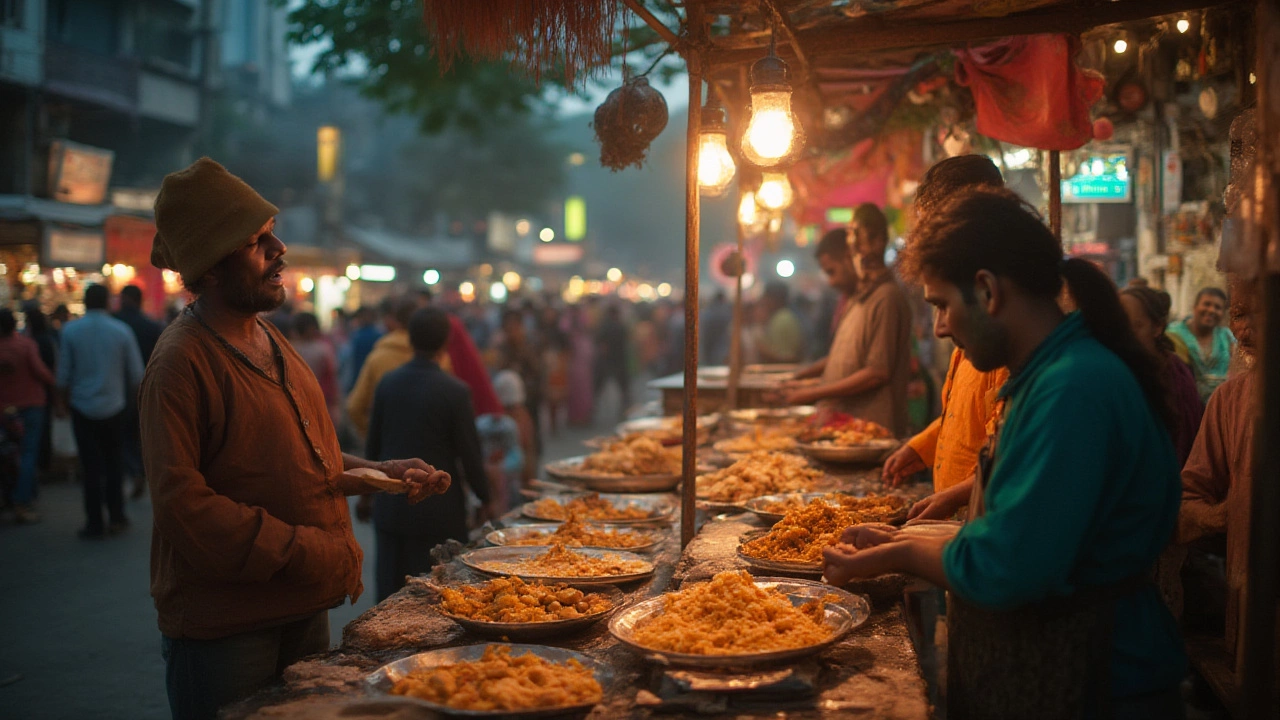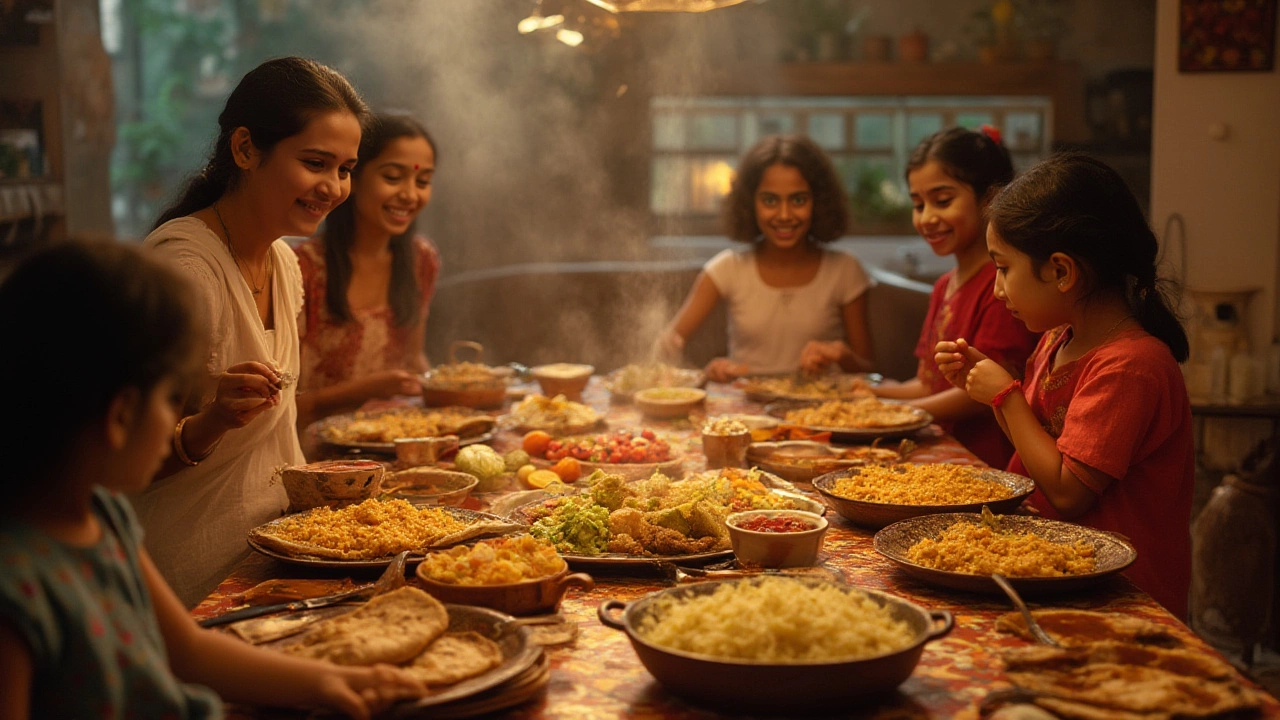6 Jul 2025
- 0 Comments
If you think Indian food is just curry, you’re missing out on a wild, flavorful story. With over 1.4 billion people and at least 22 official languages, India’s food scene is anything but boring. Ever wondered what actually ends up on the dinner plate in most Indian homes? Spoiler: it isn’t all butter chicken and samosas.
Staple Foods: The True Backbone of Indian Meals
Let’s get one thing straight—if there’s one food that unites the north, south, east, and west of India, it’s rice. But don't rush to pack away your wheat flour just yet. In the north and west, wheat is nearly as essential. Most Indians eat either rice or wheat-based bread (like chapati or roti) with nearly every meal. According to the National Sample Survey Office’s 2023-24 report, around 52% of rural Indian households eat rice as a main staple, while 36% go for wheat. It’s more than just numbers—it’s what fills lunchboxes, thalis, and midnight cravings.
If you peek into a regular kitchen in Kolkata or Chennai, you’ll spot massive sacks of rice. Shift over to Delhi or Punjab, and fluffy rotis made from wheat rule the table. Some families even switch between wheat and rice during the week. And, just to add to the mix, there are other regional staples—bajra (pearl millet) and jowar (sorghum) in Maharashtra and Gujarat sneak into daily meals, especially when there’s a winter nip in the air.
So why rice and wheat? For one, they grow everywhere—from the floodplains of Bengal to the dry fields of Punjab. They're cheap, filling, and just work with anything—spicy veggie curries, daal (lentil stew), yogurt, pickles... you name it. If you’ve ever visited an Indian house, you were probably offered a steaming bowl of rice and something amazing to go with it. That’s just how food hospitality works here.
Dig a little deeper into what’s eaten with these staples, and you’ll see a real love for pulses (think lentils, chickpeas, and beans). In fact, India is the world's largest producer and consumer of pulses, with the UN Food and Agriculture Organization estimating about 18 million tonnes consumed in 2024. A simple daal chawal—spiced lentils over rice—is a comfort meal for millions. For families trying to keep food affordable and healthy, pulses are a real lifesaver—they pack protein, are easy to store, and are loaded with flavor when spiced right.
Vegetables, Spices, and The Great Indian Flavor Bomb
Sure, India loves its staples, but what makes every plate memorable is what goes on the side. Fresh vegetables are everywhere. Potato, onion, tomato, spinach, okra… these all feature in some form, morning to night. And if you walk into a bustling local market—called a sabzi mandi—you’ll see just how many varieties people pick up in a single day. An average Indian household will use at least five to seven different vegetables a week, and shopping multiple times a week isn’t rare at all. Fresh is just non-negotiable around here.
Now let’s talk about spices. Forget bland food—Indian kitchens are packed with tiny tins and boxes of spices. Turmeric, cumin, coriander, mustard seeds, and chili powder turn even basic boiled potatoes into something you’ll crave. It’s not about burn-your-mouth heat (unless you’re in Andhra Pradesh—then watch out), but about layering flavors for maximum impact. You’ll find ‘garam masala’, a warming blend of spices, in so many home style curries. There’s actual research showing that Indian cooking uses ‘negative food pairing’—in other words, mixing ingredients that have very different flavor molecules, which is why everything tastes so intriguing.
But before you think it’s all vegetarian, let’s set the record straight. Around 71% of Indians eat a mostly plant-based diet, according to a 2024 Pew survey. But that still leaves hundreds of millions who love their meats. Chicken curry, fish fry in Bengal, mutton biryani in Hyderabad, egg masala—meat dishes are everywhere, especially during festivals or Sundays. Fish is a true staple in the east and south where coasts are near. But meat is often pricier, so daily meals tend to stay mostly vegetarian out of practicality.
Fermented foods, pickles, and chutneys deserve their own shout-out. Whether it’s pungent mango pickle in summer, tangy green chutney, or crunchy papad on the side, every meal gets a flavor boost. These add interest, cut through richer curries, and help balance taste. Some pickles use over ten different spices, aged for months, which is just classic Indian patience and culinary obsession in one jar.

The Allure of Street Food and Special Dishes
If there’s one thing visitors remember, it’s the chaos and magic of Indian street food. At every corner, whether you’re backpacking in Varanasi or catching a rickshaw in Mumbai, you’ll see someone tossing food in a giant wok or stacking spicy snacks in paper cones. But what are people snacking on most?
Pani puri (also called golgappa or puchka) tops the chart for both popularity and frequency. You get crisp little puris, fill them with spicy tangy water, potato, and chickpeas, and pop them in your mouth. The rush of flavors is addictive. Close on its heels: samosas—triangle pastries stuffed with spicy potatoes—and chaat, a crazy delicious mix of crispy stuff, boiled potatoes, yogurt, and chutney.
Each city has its own cult classics. Mumbai has vada pav—a garlicky potato fritter in a bun—eaten by millions every day. Delhi and Lucknow compete for the title of best kebabs. Down south, it’s crispy dosa filled with spiced potatoes and served hot with coconut chutney. The point is, for millions, street food isn’t just a treat—it’s breakfast, lunch, and snack-time in one.
Now let’s pull out the real numbers: according to Zomato’s 2024 food trend survey, Indian-style biryani is officially the most-ordered dish online, with an average of 2 orders placed every second in cities alone. That’s right, not pizza or burgers—biryani. Each region does it differently (Hyderabadi, Lucknowi, Kolkata styles), but it’s always loaded with aromatic rice, spiced meat or vegetables, fried onions, and magic.
Indians are crazy about snacks, but don’t forget daily sweets. Chai (strong, sweet milk tea) is non-negotiable for most adults, and it’s often paired with biscuits or mithai (traditional sweets). Names like gulab jamun, jalebi, or barfi pop up at every festival and guest visit. Many families make these at home, but sweet shops doing brisk business on every street corner are impossible to ignore.
Regional Twists and Eating Habits Across India
With a country as massive as India, it’s no shocker that food changes every few hundred kilometers. Five-star hotels brag about subtle flavors in royal Mughlai dishes from Delhi, but step outside, and you’ll see home cooks making their own versions with whatever’s cheap and fresh that day. In the south, breakfast is often a steamy plate of idli (fermented rice cakes) and coconut chutney. Bengal serves fish curry and rice sometimes three times a day—the Ganges delta just keeps delivering that fresh catch.
Folks in Gujarat eat mostly vegetarian, with plenty of sweet-salty combos—think dhokla (savory steamed cake) and theplas (spiced flatbread). Rajasthan loves its spicy, ghee-rich curries, built to survive hot dry weather. Up in Kashmir, food leans to the hearty side, with rogan josh (spicy mutton curry) and saffron-infused rice. India’s northeast opens a new world with fermented bamboo shoots, pork, and wild greens, showing how much influence geography has on the food plate.
Let’s get into eating habits, too. Most Indians still eat two to three main meals a day, with smaller snacks in between. Food is almost never eaten alone—mealtimes are social, whether it’s families at home or colleagues squatting around a lunchbox at work. Eating with hands is common, especially with rice or bread, because it’s believed to engage all the senses (and, honestly, it’s just more fun). Stainless steel thalis (compartment plates) keep everything in its place, and lunchboxes for schoolkids are stuffed with chapatis rolled around dry curry or rice with a sprinkle of masala powder.
Festivals and special occasions explode with food. Diwali, Ramadan, Onam, Christmas—each region pats itself on the back for its feast days, loaded with sweets, rich biryanis, or whatever the seasonal bounty is. Food is seen as a way to connect, celebrate, and showcase hospitality. Refusing to eat is almost considered rude—there’s always room for “just one more bite.”
Here's a look at an authentic snapshot of what Indians eat in a typical week. These stats are from the India Food Consumption Survey (2024):
| Food Item | Average Weekly Consumption (per person) |
|---|---|
| Rice | 3.6 kg |
| Wheat (chapati, bread) | 2.4 kg |
| Pulses (daal, beans, lentils) | 850 g |
| Potatoes & root vegetables | 1.1 kg |
| Green leafy vegetables | 540 g |
| Meat and Fish | 310 g |
| Dairy (milk, curd, paneer) | 2.2 L |
| Edible oils & ghee | 300 mL |
| Sweets | 180 g |
Plant-based dishes dominate, with rice and wheat leading every chart. Meat is often a side act, not the star. Sweets and dairy see a spike around winters and festivals. Oils and ghee are essential—they add flavor and help with nutrient absorption, especially in vegetarian diets.
If you travel across India, your taste buds will never get bored. Each region, community, and even household tweaks classic dishes. There’s always something bubbling away, a new spice mix to try, and a different take on what a ‘normal meal’ looks like. And that, honestly, is what makes Indian food culture so much fun to explore—whether you’re at a family kitchen in Chennai, a street stall in Mumbai, or just poking through your local Indian grocery store in Sydney. If you love flavor and variety, you’ll never run out of new discoveries on the Indian plate.
